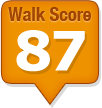Walk Score measures the walkability of any address, Transit Score measures access to public transit, and Bike Score measures whether a location is good for biking.
The Walk Score methodology has been validated by leading academic researchers.
Planners and Analysts: Learn about using Walk Score data in your research.

Walk Score measures the walkability of any address using a patented system. For each address, Walk Score analyzes hundreds of walking routes to nearby amenities. Points are awarded based on the distance to amenities in each category. Amenities within a 5 minute walk (.25 miles) are given maximum points. A decay function is used to give points to more distant amenities, with no points given after a 30 minute walk.
Walk Score also measures pedestrian friendliness by analyzing population density and road metrics such as block length and intersection density. Data sources include Google, Factual, Great Schools, Open Street Map, the U.S. Census, Localeze, and places added by the Walk Score user community.
| Walk Score® | Description |
|---|---|
| 90–100 | Walker's Paradise Daily errands do not require a car. |
| 70–89 | Very Walkable Most errands can be accomplished on foot. |
| 50–69 | Somewhat Walkable Some errands can be accomplished on foot. |
| 25–49 | Car-Dependent Most errands require a car. |
| 0–24 | Car-Dependent Almost all errands require a car. |
Find apartments in the most walkable large U.S. cities: New York, San Francisco and Boston. Find real estate in New York, San Francisco, and Boston.

Transit Score is a patented measure of how well a location is served by public transit. Transit Score is based on data released in a standard format by public transit agencies.
To calculate a Transit Score, we assign a "usefulness" value to nearby transit routes based on the frequency, type of route (rail, bus, etc.), and distance to the nearest stop on the route. The "usefulness" of all nearby routes is summed and normalized to a score between 0 - 100.
View a map of where we provide Transit Score — or for a full Transit Score geek out, read the detailed Transit Score methodology.
| Transit Score® | Description |
|---|---|
| 90–100 | Rider's Paradise World-class public transportation. |
| 70–89 | Excellent Transit Transit is convenient for most trips. |
| 50–69 | Good Transit Many nearby public transportation options. |
| 25–49 | Some Transit A few nearby public transportation options. |
| 0–24 | Minimal Transit It is possible to get on a bus. |
Find apartments in the highest transit ranking U.S. cities: New York, San Francisco and Boston. Find real estate in New York, San Francisco, and Boston.

Bike Score measures whether an area is good for biking. For a given location, a Bike Score is calculated by measuring bike infrastructure (lanes, trails, etc.), hills, destinations and road connectivity, and the number of bike commuters.
These component scores are based on data from the USGS, Open Street Map, and the U.S. Census.
Read the detailed Bike Score methodology.
| Bike Score | Description |
|---|---|
| 90–100 | Biker's Paradise Daily errands can be accomplished on a bike. |
| 70–89 | Very Bikeable Biking is convenient for most trips. |
| 50–69 | Bikeable Some bike infrastructure. |
| 0–49 | Somewhat Bikeable Minimal bike infrastructure. |
Find apartments in the most bikeable large U.S. cities: Portland, San Francisco and Denver. Find real estate in Portland, San Francisco, and Denver.

Walk Score Point Grid
To rank cities and neighborhoods, we calculate the Walk Score of approximately every city block (technically a grid of latitude and longitude points spaced roughly 500 feet apart).
Each point is weighted by population density so that the rankings reflect where people live and so that neighborhoods and cities do not have lower scores because of parks, bodies of water, etc.
For our Walk Score ranking, we define "large cities" as the 50 largest U.S. cities. For our Transit Score and Bike Score ranking, we define "large cities" as cities with more than 300,000 people.